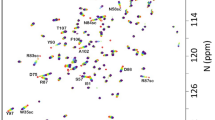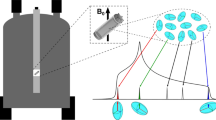Abstract
In this work, the proton spin–lattice (T1) and spin–spin (T2) relaxation times of aqueous solutions of bovine serum albumin (BSA) were investigated as a function of temperature. The T1 relaxation times were measured versus temperature (T) for five H2O solutions containing different BSA concentrations. The sample temperature was varied from 304 to 253 K for each concentration. T2 measurements were carried out versus the BSA concentrations only. The least-square fitting of ln(T1) versus T−1 yields a linear correlation. The effective correlation times \(\tau_{1}\) for T1 and \(\tau_{2}\) for T2 were calculated by using experimental data and the related theory. The data suggest that surface water is responsible for the dipolar relaxation mechanisms. Both T1 and T2 mechanisms are caused by overall tumbling of albumin molecule causing the rotational correlation time. However, some slow motions may contribute to the T2 mechanism.



Similar content being viewed by others
References
Valckenborg, R.M.E.: NMR on Technological Porous Materials. Eindhoven University of Technology, Eindhoven (2001)
Van-Quynh, A., Willson, S., Bryant, R.G.: Protein reorientation and bound water molecules measured by 1H magnetic spin-lattice relaxation. Biophys. J. 84, 558–563 (2003)
Yoshıoki, S.: Dynamics of a protein and water molecules surrounding the protein: hydrogen-bonding between vibrating water molecules and a fluctuating protein. J. Comput. Chem. 23, 402–413 (2002)
Bertini, I., Gupta, Y.K., Luchinat, C., Parigi, G., Schlörb, C., Schwalbe, H.: NMR Spectroscopic detection of protein protons and longitudinal relaxation rates between 0.01 and 50 MHz. Angew. Chem. 44, 2223–2225 (2005)
Kay, L.E., Nicholson, L.K., Linda, K., Delaglio, F., Bax, A., Torchia, D.A.: Pulse Sequences for removal of the effects of cross correlation between dipolar and chemical-shift anisotropy relaxation mechanisms on the measurement of heteronuclear TI and T2 values in proteins. J. Magn. Reson. 97, 359–375 (1992)
Kavak, G., Yılmaz, A., Morris, G., Heatley, F.: Investigation of the hydration of bovine serum albumin by an NMR titration method. Asian J. Chem. 22, 1355–1359 (2010)
Köylü, M.Z., Asubay, S., Yılmaz, A.: Determination of proton relaxivities of Mn(II), Cu(II) and Cr(III) added to solutions of serum proteins. Molecules 14, 1537–1545 (2009)
Bokor, M., Csizmók, V., Kovács, D., Bánki, P., Friedrich, P., Tompa, P., Tompa, K.: NMR relaxation studies on the hydrate layer of intrinsically unstructured proteins. Biophys. J. 88, 2030–2037 (2005)
James, T.L.: Nuclear Magnetic Resonance in Biochemistry. Academic Press, New York (1975)
Fullerton, G.D., Ord, V.A., Cameron, I.L.: An evaluation of the hydration of lysozyme by an NMR titration method. Biochim. Biophys. Acta 869, 230–246 (1986)
Koenig, S.H.: Classes of hydration sites at protein–water interfaces: the source of contrast in magnetic resonance imaging. Biophys. J. 69, 593–603 (1995)
Bryant, R.G.: The dynamics of water protein interactions. Ann. Rev. Biophys. Biomol. Struct. 25, 29–53 (1996)
Yılmaz, A., Budak, H., Ulak, F.S.: Determination of the effective correlation time modulating 1H NMR relaxation processes of bound water in protein solutions. Magn. Reson. Imaging 26, 254–260 (2008)
Jun, J.Y., Hoang, H.N., Paik, S.Y.R., Chun, H.S., Kang, B.C., Ko, S.: Preparation of size-controlled bovine serum albumin (BSA) nanoparticles by a modified desolvation method. Food Chem. 127, 1892–1898 (2011)
Fitter, J.: The temperature dependence of internal molecular motions in hydrated and dry alpha-amylase: the role of hydration water in the dynamical transition of proteins. Biophys. J. 76, 1034–1042 (1999)
Vesanen, P.T., Zevenhoven, K.C.J., Nieminen, J.O., Dabek, J., Parkkonen, L.T., Ilmoniemi, R.J.: Temperature dependence of relaxation times and temperature mapping in ultra-low-field MRI. J. Magn. Reson. 235, 50–57 (2013)
Kakule, J.F., Sharp, A.R., Schreiner, L.J., Thompson, R.T., Kupka, T., Holly, R., Peemoeller, H.: Cross-relaxation bottleneck in water–lysozyme proton magnetization exchange. Biopolymers 83, 11–19 (2006)
Daskiewicz, O.K., Hennel, J.W., Lubas, B.: Proton magnetic relaxation and protein hydration. Nature 200, 1006–1007 (1963)
Yoshioka, S., Aso, Y., Kojima, S.: Softening temperature of lyophilized bovine serum albumin and gamma-globulin as measured by spin–spin relaxation time of protein protons. J. Pharm. Sci. 86, 470–474 (1997)
Yılmaz, A., Yurdakoç, M., Isik, B.: Influence of transition metal ions on NMR proton T1 relaxation times of serum, blood, and red cells. Biol. Trace Element Res. 67, 187–193 (1999)
Fullerton, G.D.: Physiologic basis of magnetic relaxation. Mag. Reson. Imaging 10, 88–108 (1992)
Prosser, S., Peemoeller, H.: Nature of lysozyme–water interactions by proton NMR. Biochem. Cell Biol. 69, 341–345 (1991)
Köylü, M.Z., Budak, H.: Temperature dependence of NMR T1 relaxation of dibenzo diaza 18-crown-6 ether derivative in solution. Asian J. Chem. 19, 2349–2352 (2007)
Gallier, J., Rivet, P., de Certaines, J.: 1H- and 2H-NMR study of bovine serum albumin solutions. Biochim. Biophys. Acta 915, 1–18 (1987)
Koenig, S.H., Schillinger, W.E.: Nuclear magnetic relaxation dispersion in protein solutions. I. Apotransferrin. J. Biol. Chem. 244, 3283–3289 (1969)
Gösch, L., Noack, F.: NMR relaxation investigation of water mobility in aqueous bovine serum albumin solutions. Biochim. Biophys. Acta 453, 218–232 (1976)
Fullerton, G.D., Finnie, M.F., Hunter, K.E., Ord, A., Cameron, I.L.: The influence of macromolecular polymerization on spin-lattice relaxation of aqueous solutions. J. Magn. Reson. Imaging 5, 353–370 (1987)
Cameron, I.L., Ord, V.A., Fullerton, G.D.: Water of hydration in the intra- and extracellular environment of human erythrocytes. Biochem. Cell. Biol. 66, 1186–1199 (1988)
Yılmaz, A., Zengin, B., Ulak, F.S.: NMR proton spin-lattice relaxation mechanism in D2O solutions of albumin determined at 400 MHz. J. Appl. Spect. 81, 365–370 (2014)
Korunur, S., Zengin, B., Yılmaz, A.: 400 MHz NMR study of isotope effects on albumin in H2O/D2O solutions. Russ. J. Phys. Chem. A 92, 1932–1934 (2018)
Schuhmacher, J.H., Clorıus, J.H., Semmler, W., Hauser, H., Matys, E.R., Maier-Borst, W., Hull, W.E.: NMR relaxation times T1 and T2 of water in plasma from patients with lung carcinoma: correlation of T2 with blood sedimentation rate. Magn. Reson. Med. 5, 537–547 (1987)
McLachlan, L.A.: Cancer-induced decreases in human plasma proton NMR relaxation rates. Phys. Med. Biol. 25, 309–315 (1980)
Halle, B.: Protein hydration dynamics in solution: a critical survey. Philos. Trans. R. Soc. London B. 359, 1207–1224 (2004)
Budak, H., Köylü, M.Z., Yılmaz, U.N.: The effective correlation time τ in jaw cysts determined from 400 MHz NMR T1 and T2 measurements. Spectroscopy 20, 177–183 (2006)
Acknowledgements
This research was supported by the Technological Research Council of Turkey (TÜBİTAK). Thanks to Professor Gareth Morris of Manchester University, and Professor Ali Yılmaz of Batman University for their assistance.
Funding
This research received no external funding.
Author information
Authors and Affiliations
Corresponding author
Ethics declarations
Conflict of interest
The authors declare no conflict of interest.
Additional information
Publisher's Note
Springer Nature remains neutral with regard to jurisdictional claims in published maps and institutional affiliations.
Rights and permissions
About this article
Cite this article
Kavak Balcı, G. Investigation of Temperature Dependence of Protein Solutions by NMR Spectroscopy. J Solution Chem 50, 232–239 (2021). https://doi.org/10.1007/s10953-021-01052-z
Received:
Accepted:
Published:
Issue Date:
DOI: https://doi.org/10.1007/s10953-021-01052-z




